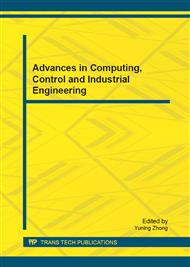[1]
Tao Li, A unified view on clustering binary data, Machine Learning, v 62, n 3, pp.199-215, March (2006).
Google Scholar
[2]
Javad, Azimi, XiaoliFern, Adaptive Cluster Ensemble Selection, In Proceedings of International Joint Conference on Artificial Intellegence, IJCAI 2009, pp.993-997.
Google Scholar
[3]
Fred A L, Jain A K, Data clustering using evidence accumulation, , Proceedings of the 16th International Conference on Pattern Recognition (ICPR 2002). volume 4, 2002: 276-280.
Google Scholar
[4]
A. Strehl, J. Ghosh, Cluster Ensemble-a knowledge reuse framework for combining Multiple partitions, Journal on Machine Learning Research(JMLR), vol 3, 2002, pp.583-617.
Google Scholar
[5]
Xiaoli Z. Fern, Carla E. Brodley, Solving cluster ensemble problems by bipartite graph partitioning, in Proceedings of 21th International Conference on Machine learning (ICML2004), pp.281-288.
DOI: 10.1145/1015330.1015414
Google Scholar
[6]
Vega-Pons, Sandro, Ruiz-Shulcloper, José Source, A survey of clustering ensemble algorithms , International Journal of Pattern Recognition and Artificial Intelligence, vol. 25, pp.337-372, May (2011).
DOI: 10.1142/s0218001411008683
Google Scholar
[7]
Xiaoli Z. Fern, Carla E. Brodley, Solving cluster ensemble problems by bipartite graph partitioning, in Proceedings of 21th International Conference on Machine learning (ICML2004), pp.281-288.
DOI: 10.1145/1015330.1015414
Google Scholar
[8]
Ayad, H, Kamel, Finding natural clusters using multi-clusterer combiner based on shared nearest neighbors", Proceedings of the 4th International Workshop on Multiple Classifier Systems (MCS, 03), 2003. Volume 2709 of Lecture Notes in Computer Science. Springer, 2003: 166-175.
DOI: 10.1007/3-540-44938-8_17
Google Scholar
[9]
Chris Ding, Xiaofeng He, Horst D. Simon. On the Equivalence of Nonnegative Matrix Factorization and Spectral Clustering"Proc. SIAM Int'l Conf. Data Mining (SDM, 05), pp: 606-610, April (2005).
DOI: 10.1137/1.9781611972757.70
Google Scholar
[10]
Tao Li , Chris Ding. The Relationships Among Various Nonnegative Matrix Factorization Methods for Clustering"Proc. IEEE Int'l Conf. on Data Mining (ICDM, 06) 2006. pp.362-371.
DOI: 10.1109/icdm.2006.160
Google Scholar
[11]
Zhongyuan Zhang, Tao Li, Chris Ding, Xian-Wen Ren, Xiangsun Zhang. Binary matrix factorization for analyzing gene expression data,. Data Min. Knowl. Discov. 20(1): 28-52 (2010).
DOI: 10.1007/s10618-009-0145-2
Google Scholar
[12]
Tao Li, Chris Ding, and Michael I. Jordan. Solving consensus and semi-supervised clustering problems using nonnegative matrix factorization,. In ICDM, (2007).
DOI: 10.1109/icdm.2007.98
Google Scholar


